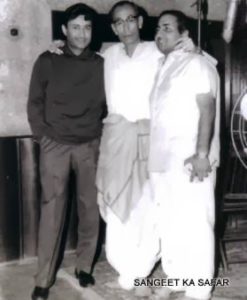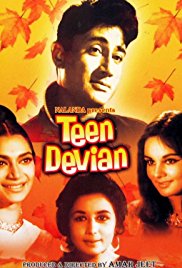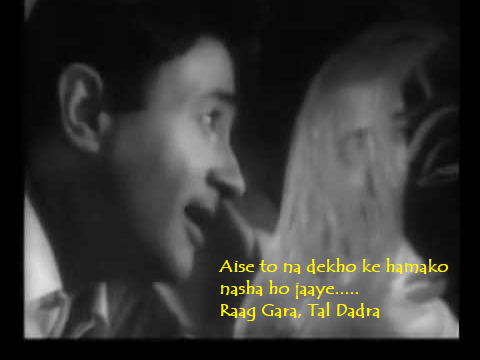Raaga Based Song of the Day: Aise to na dekho ke hamako nasha ho jaaye….
Raag Gara, Tal Dadra

Sachin Dev Burman had a great affinity for his Dev Anand; so much so that the former used to say that his middle name Dev was for his favourite star, Dev Anand.
Amitabh on Sunday shared a black and white photograph of Rafi, Dev Anand and Burman and captioned: “What an amazing combination – Mohammed Rafi, Dev Anand and the maestro SD Burman. They together gave incredible music to the industry.”The three collaborated for the songs like ‘Khoya Khoya Chand Khula Aasman’ from the 1960 film ‘Kala Bazar’. Many would recall that Rafi started singing for SD Burman much earlier (1947 movie Do Bhai, for example, with the song: Duniya mein mere aaj andhera hi andhera) than Kishore. Their best was in 1957 iconic movie of Guru Dutt: Pyaasa with such unforgettable songs such as: Yeh duniya agar mil bhi jaaye to kyaa hai, Jinhe naaz hai Hind par wo kahan hain, and Tang aa chuke hain kashm-e-kashe zindagi se ham.
As far as the trio together is concerned, some of their memorable movies are: Kala Pani (1958), Bambai Ka Babu, Kala Bazar (1960), Tere Ghar Ke Samne (1963), Guide, and Teen Deviyan (1965).
Today’s song is from the 1965 Amarjeet movie Teen Devian that had three women Simi Grewal, Kalpana and Nanda all rooting for Dev Anand. Please remember that I am putting up, in this series, only raaga based songs.
I have given another song in Raag Gara, Tal Kaherava earlier: my second song at that: Unake khayal aaye to aate chale gaye (Please see: ‘Raaga Based Song Of The Day #2‘).
We have completed sixty-six days of Raaga Based Songs of the Day. Our first post in the series was titled ‘Raaga Based Song Of The Day #1’ and the song was a Mohammad Rafi and Lata Mangeshkar song from the 1970 Shakti Samanta movie Pagla Kahin Ka: Tum mujhe youn bhula na paoge. It is in Raag Jhinjhoti, Tal Kaherava.
Our sixty-sixth post or the last post was titled ‘Raaga Based Song Of The Day #66‘ and the song was a Lata Mangeshkar song from the 1960 Hrishikesh Mukherjee movie Anuradha starring Leela Naidu and Balraj Sahni: Kaise din beete kaise beeti ratiya. It is in Raag Manj Khmmaj, Tal Kaherava.
This blog has a number of posts on Raaga based songs in Hindi movies titled similarly; for example: ‘The Best Raaga Based Songs in Hindi Movies – Raaga Jaijaivanti‘.
In the last sixty-six days of sharing Raaga based songs of the day, I have given you songs based on Raag Jhinjhoti, Gara, Bhimpalasi, Madhuvanti, Shivaranjani, Bihag, Pahadi, Sarang, Pilu, Bhairavi, Khammaj, Charukesi, Kalyan or Yaman, Desh, Malgunji, Kirwani, Kedar, Bageshri, Megh Malhar, Bhupali, Ahir Bhairav, Malkaush, Mand, Adana, Kafi, Rageshri, Jaunpuri, Tilang, Janasammohini, Chayanat, Shuddha Kalyan, Gaur Sarang, Jogiya, Asavari, Maru Bihag, Durga, Lalit, Puria Dhanashri, Bhinna Sahdja, Sohani, Multani, Patdeep, Jaijaiwanti, Tilak Kamod, Hemant, Basant Mukhari, Gujri Todi, Kalavati, Hamir, Bhatiyar, Gawati, Shyam Kalyan, Gorakh Kalyan, Madhamat Sarang and Manj Khammaj. The only five raagas that have been repeated so far are Pahadi, the raaga of my home place in the Himalayas, Maru Bihag, Raag Kirwani, Jhinjhoti and Bhairavi. That makes a total of 55 raagas so far. Today, I am repeating Raag Gara.
Today’s song has been sung by Mohammad Rafi on the lyrics of Majrooh Sultanpuri, the only lyricist to have been awarded the highest: Dadasaheb Phalke Award, and on a composition by Sachin Dev Burman. As I said, it is in Raag Gara, Tal Kaherava.
However, first, lets take up the value added learning of today. Today, we shall have a look at use of raagas for good health as well as for treatment of diseases.
For a long time, ancient Indians believed that music had value much more than just the entertainment value of it. Music was considered a powerful tool to make us come closer to our inner selves and God. At a fairly early stage, I told you about the season and the time of day and night that a certain raag could be played to derive maximum benefit from it. Both were considered important to get into the emotion (bhaav) of the raaga to obtain the optimum that the raaga had to offer.
The health benefits of listening to specific raaga at a specific time have been proved to the extent that lately there is renewed interest in it. There are, now, a number of institutes that treat you with music either by itself or as a supplement to medicine. From the reading of ancient texts, it has been derived that singing a particular raaga has even more benefits than merely listening to it.
Right vibes? Well, Indian civilization was, in ancient times, already experimenting with the vibrations with therapeutic value that certain music produced.
Don’t believe me? Well, read about Nada Yoga, for example. Nada Yoga is all about the impact that music has on body and mind (ancient Indians thought of both being seamless) and in uplifting one’s level of consciousness. What do received vibrations from music do? Well, they can cause resonance in one’s mind and synchronise it to the mood of the raaga. As I said, either that by itself could have health benefits or as a supplement.
Do you remember when I told you about the moods that raagas could induce? Well, now imagine how raagas could intensify joys, positivity, peace etc in the listener or the singer. Therefore, it is easy to guess that only certain types of raagas could have health benefits.
Lets now think about the origin of raagas itself in ancient India. Please remember what I told you about the chanting of Vedic mantras in praise of God or gods and goddesses and how that was used to get positive benefits to individuals as well as to remove disharmony in either self or society. Gradually, we had a stream called Raaga Chikitsa (Raaga as a Doctor). Just to give an example, Haridas Swamy, who was Tansen’s Guru in the court of Emperor Akbar, had actually treated one of the queens with only music and she recovered.
Legend has it that Saint Thyagaraja brought a dead person back to life with his Bilahari composition Naa Jiva Dhaara. Muthuswamy Dikshitar’s Navagriha Kriti is believed to cure stomach ache. Shyama Sastry’s composition Duru Sugu uses music to pray for good health.
Raaga Chikitsa was an ancient manuscript, which dealt with the therapeutic effects of raaga. The library at Thanjavur is reported to contain such a treasure on raagas, that spells out the application and use of various raagas in fighting common ailments.
So, in addition to just the acoustic vibrations, in Raaga Therapy, it is believed that they relied on magnetic and electro-magnetic energy too with concomitant effect on physiological and psychological components.
According to an ancient Indian text, Swara Shastra, the seventy-two melakarta raagas (parent raagas ) control the 72000 important nerves (nadis) in the body. It is believed that if one sings with due devotion, adhering to the raaga lakshana (norms) and sruti shuddhi (pitch purity), the raga could affect the particular nerve in the body in a favourable manner.
I am sure, by now, I have evoked adequate interest in health benefits of raagas. Here is just an example in real terms now (there is much more to be studied):
1. Raga Pooriya Dhansari (Hamsanandi-Kamavardini ) – evokes sweet, deep, heavy, cloudy and stable state of mind and prevents acidity..
2. Raga Bageshri – arouses a feeling of darkness, stability, depths and calmness. This raga is also used in treatment of diabetes and hypertension.
3. Raga Darbari (Darbari Kanada) – is considered very effective in easing tension. It is a late night raga composed by Tansen for Akbar to relieve his tension after hectic schedule of the daily court life.
4. Raga Todi – give treamendous relief to patients of high blood pressure.
5. Raga Ahir-Bhairav (Chakravakam) – is supposed to sustain chords which automatically brings down blood pressure.
6. Raga Malkauns – helps to cure low blood pressure.
7. Raga Bhairavi – Provides relief T.B, Cancer, Severe Cold, Phlegm, Sinus, toothache .
8. Raga Malhar – Useful in the treatment of asthma and sunstroke.
9. Raga Todi– Provides relief from cold and headache.
10. Raga Hindol & Marava – These ragas are useful in blood purification.
As I mentioned, today’s song is composed in Raag Gara, Tal Kaherava.
Raag Gara belongs to the Khammaj Thaat. Its Jati is Shadhav-Sampoorna, that is six notes in Aaroha (five notes except Rishab) and has all seven notes in Avaroha. The time for singing this raag is second part of morning. Khammaj Thaat’s pictorial description is sensuous and raagas derived from it have a certain degree of flirtatious mood about it. Listen to the song that I have selected for you and you will know what I mean.
Some of the songs composed in Raag Gara are:
| 1. 2. 3. 4. 5. 6. 7. 8. 9. 10. 11. 12. 13. 14. 15. 16. 17. 18. 19. 20. 21. 22. 23. 24. 25. |
Mohe Panghat Pe Bol Mere Nandlala Deewana Kehke Aaj Is Paar Saajan Kabhi Khud Pe Tu Kahan Kho Gaya Unke Khayal Aaye Kasme Hum Unki Do Roz Mein Jab Jab Tumhein Jo Guzar Rahi Hai Chehere Se Apne Guzre Hain Aaj Aapki Nazaron Ne Aapki Baatein Karein Phir Woh Bhuli Si Mein To Tere Haseen Apni Khushi Se Aaya Koi Khayal Mera Mann Tera Pyasa Aise To Na Dekho Aajkal Humse Roothe Chhodo Baeeyan Hamari Aankhon Mein Teri Yaad Main Nigahein tere |
Mughal-E-Azam Bahana Mulzim Chori Chori Hum Dono Singapore Lal Pathar Mere Gareeb Nawaaz Pyar Ki Raahein Jahanara Mere Huzoor Paalki Dil Diya Dard Liya Anpadh Dil Ki Raahein Begana Sangraam Kunwara Badan Tarana Gambler Teen Deviyan Aamne Samne Tarana Hamari Yaad Aayegi Aapki Parchhaeeyan |
Lata Lata Rafi Lata Rafi Lata Rafi Anwar Mukesh Lata, Asha Rafi Rafi Rafi Lata Lata Rafi Rafi Lata Vani Jayram Rafi Rafi Rafi Aarti Mukesh Rafi |

The song Aise to naa dekho is from the 1965 Amarjeet movie Teen Devian starring Dev Anand with his three women: Simi Grewal, Kalpana and Nanda. The movie had remarkably beautiful songs penned by Majrooh Sultanpuri and composed by SD Burman: Are yaar meri tum bho ho gazab, Kahin bekhayal ho kar mujhe chhu liya kisine, Khwaab ho tum ya koi haqeeqat, and Likha hai teri aankhon mein.
Please enjoy in Raag Gara, Tal Kaherava: Aise to naa dekho ke hamako nasha ho jaaye….
Aise to na dekho, ke hamako nashaa ho jae
Khuubasuurat sii koI hamase Kataa ho jaae (2)
Aise to na dekho
Tum hame.n roko phir bhii ham naa ruke.n
Tum kaho kaafir phir bhii aise jhuke.n
Qadam-e-naaz pe ik sajadaa adaa ho jaaye
Aise to na dekho
Yuu.N na ho aa.Nkhe rahe.n kaajal ghole.n
Ba.Dh ke bekhudii ha.nsii.n gesuu khole.n
Khul ke phir zulfe.n siyaah kaalii balaa ho jaaye
Aise to na dekho
Ham to mastii me.n jaane kyaa kyaa kahe.n
Lab-e-naazuk se aisaa na ho tumhe.n
Beqaraarii kaa gilaa ham se sivaa ho jaaye
Aise to na dekho
We have intended to learn about Raaga based music whilst we entertain ourselves with Raaga based songs. So, lets, once again, take stock of our collective learning so far:
- On the first day we learnt about the Raaga system devised by Pandit Vishnu Narayan Bhatkhande, which is the prevalent system in Hindustani Classical Music and based on ten Thaats.
- On the second day we learnt about Tal or Taal.
- On the third day we learnt about characteristics of Raagas that included Swar, Jati, Thaat, Arohana and Avarohana, Vadi, Samvadi and Pakad.
- On the fourth day, we learnt about Sargam.
- On the fifth day, we learnt about notations used in Indian classical music or simply Swar Lipi.
- On the sixth day, we learnt about the Ras (sentiments) that Raagas evoke.
- On the seventh day, we learnt about various types of Swar: Shuddha, Achal, Vikrut, Komal and Teevra.
- On the eighth day, we learnt the parts of a composition in Indian Classical Music.
- On the ninth day, we learnt the names of some of the popular instruments used in Indian Classical Music.
- On the tenth day, we learnt about the sources of names of Raagas.
- On the eleventh day, we learnt about why Bhairavi is the first raag to be taught to beginners and also why it is the last in a performance.
- On the twelfth day, we learnt about Khammaj Thaat.
- On the thirteenth day, we learnt about Tal Punjabi Theka or Sitarkhani.
- On the fourteenth day, we learnt about Alap.
- On the fifteenth day, we learnt about List of Raagas (Raagmala) in my favourite book: Sri Guru Granth Sahib.
- On the sixteenth day, we learnt about tips for raaga identification.
- On the seventeenth day, we learnt the basics of Gharana system.
- On the eighteenth day, we learnt about Filmi Sangeet.
- On the nineteenth day, we learnt about the commonest Tal in Raagas: Tintal.
- On the twentieth day, we learnt about the Kafi Thaat.
- On the twenty-first day, we learnt a little more in detail about the classification of Raagas.
- On the twenty-second day, we learnt the essential differences between Bhairavi and Bhairav.
- On the twenty-third day, we learnt a little more in detail about the Jati or Jaati of a raaga.
- On the twenty-fourth day, we learnt details of Thaat Bilawal, the most basic thaat in the Bhatkhande’s system of raagas.
- On the twenty-fifth day, we learnt about Tintal.
- On the twenty-sixth day, we learnt in detail about the Raaga – Samay linkage.
- On the twenty-seventh day, we learnt about Lehar.
- On the twenty-eighth day, we learnt about the history of the Hindustani Music.
- On the twenty-ninth day, we learnt about Dhrupad.
- On the thirtieth day, we learnt about Rupaktal that I was introduced to, a few months back, by my friend Anand Desai.
- On the thirty-first day, we learnt about Khayal.
- On the thirty-second day, we learnt about Thumri.
- On the thirty-third day, we learnt about Tappa.
- On the thirty-fourth day, we learnt about Tarana.
- On the thirty-fifth day, we learnt about Tal Dipchandi (Moghali).
- On the thirty-sixth day, we learnt about Tabla.
- On the thirty-seventh day, we learnt about Kirtan.
- On the thirty-eighth day, we learnt about Pakhawaj.
- On the thirty-ninth day, we learnt about Hori.
- On the fortieth day, we learnt about Dadra.
- On the forty-first day, we learnt about Kajri.
- On the forty-second day, we learnt about Chaiti.
- On the forty-third day, we learnt about Sarangi.
- On the forty-fourth day, we learnt about Shehnai.
- On the forty-fifth day, we learnt about Sarod.
- On the forty-sixth day, we learnt about Bansuri.
- On the forty-seventh day, we learnt about Ektal and Tanpura.
- On the forty-eighth day, we learnt about Veena.
- On the forty-ninth day, we repeated our learning of Veena with a small excitement added.
- On the fiftieth day, we learnt about Dilruba/Esraj.
- On the fifty-first day, we learnt about Jaltarang.
- On the fifty-second day we learnt about Qawwali.
- On the fifty-third day, we learnt about Sitar.
- On the fifty-fourth day, we learnt about Surbahar.
- On the fifty-fifth day, we learnt about Harmonium.
- On the fifty-sixth day, we learnt about Santoor.
- On the fifty-seventh day, we learnt about Swarmandal.
- On the fifty-eighth day, we learnt about the Shruti Box.
- On the fifty-ninth day, we learnt about Alankar.
- On the sixtieth day, we learnt about singing in Aakaar.
- On the sixty-first day, we learnt about the Classification of Indian Musical Instruments.
- On the sixty-second day, we learnt a little about Carnatic Music.
- On the sixty-third day, we learnt about Natya Shastra.
- On the sixty-fourth day, we learnt about evolution of musical instruments in India down the ages.
- On the sixty-fifth day, we learnt about Riyaaz.
- On the sixty-sixth day, we looked at a list of Raagas in Hindustani Classical Music.
- And today, on the sixty-seventh day, we learnt about the health benefits of raagas.
There is much more still to be learnt and enjoyed.
Please stay tuned!

Mohammed Rafi has sung some really very good songs for Dev Saab . These Anand brothers were very influencial people and the people working with them gave out what was best in them .
Everything in this universe vibrates and moves to certain rhythms. These rhythms establish seasons, cycles, stages of development, and patterns. Humans evolved in these environments , are certainly affected by these rhythms , raga , music etc.
Thank you, Jaswant. With me, as I go on a journey of Raagas, I am discovering the truth of Socrates’ famous saying: “The more you know, the more you come to know how little you know.”